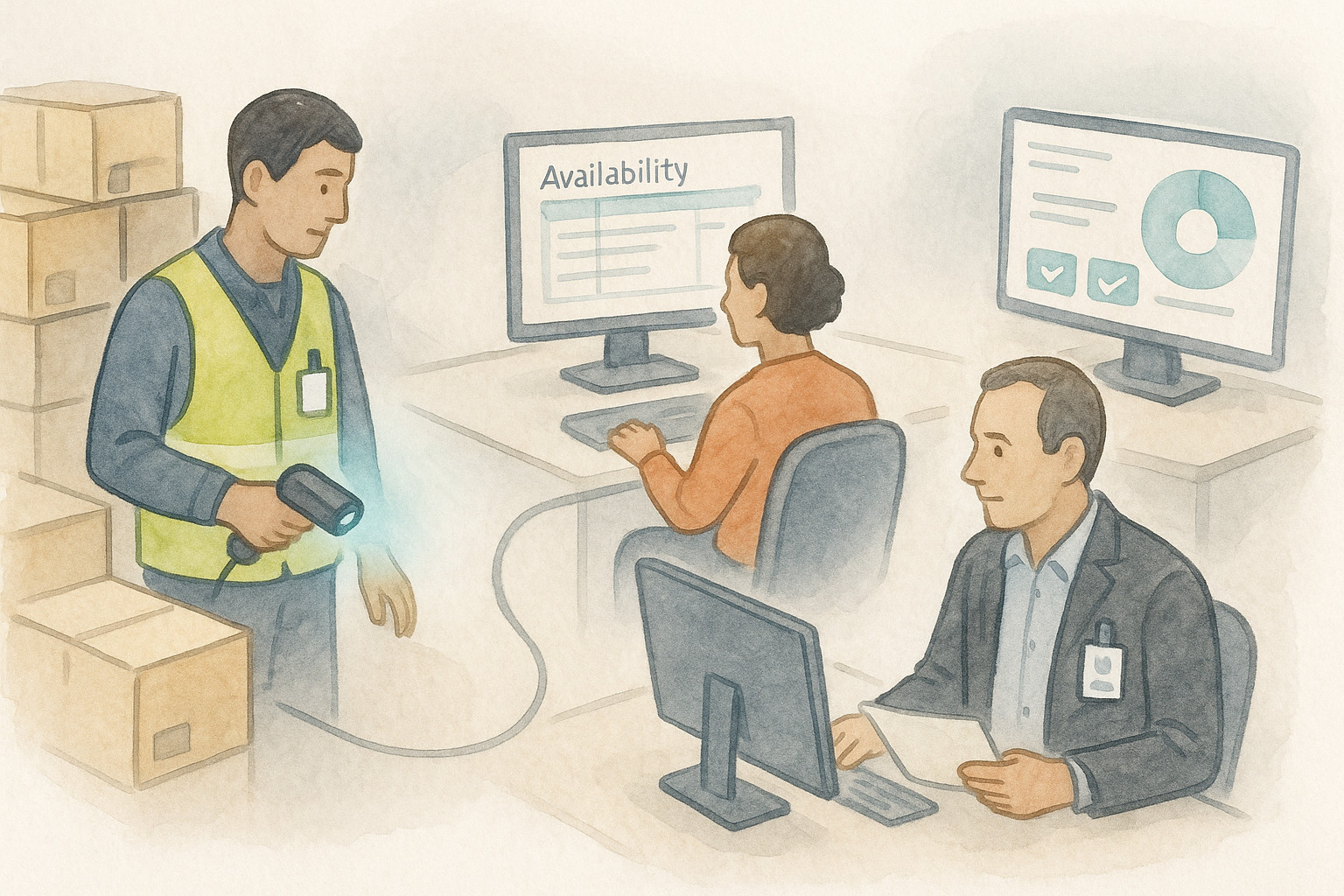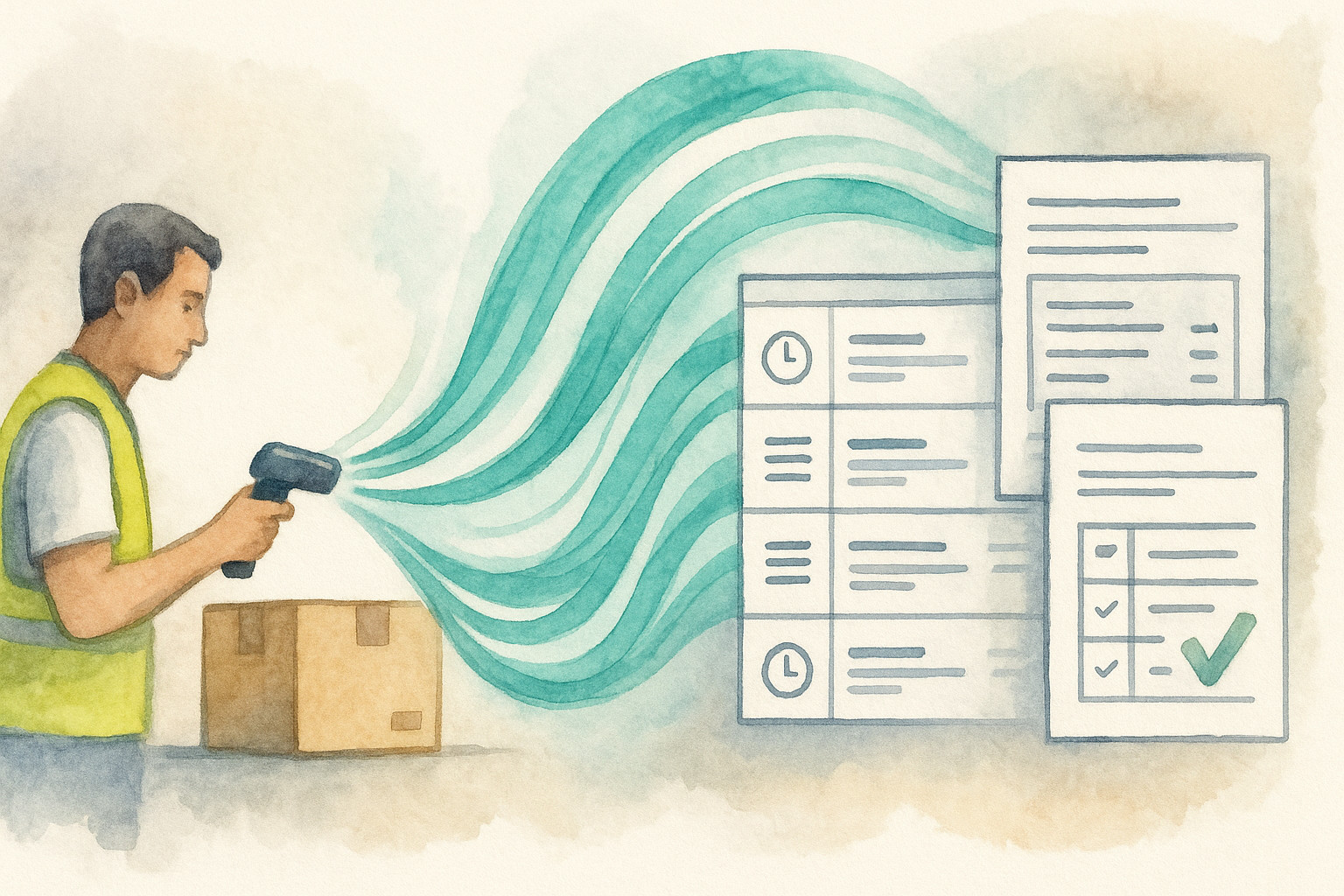B2B Inventory Security: From Shared Passwords to Role-Based Team Access
Series: Solving Critical Challenges in B2B Inventory Management
Part 2 of 4: Team Access and Collaboration
Password sharing in B2B inventory operations causes security risks, lost productivity, and compliance failures. Here's how role-based access improves team collaboration.
You just hired a new warehouse supervisor. It's their first day, and you're about to hand them access to your inventory system. The password? Written on a sticky note, shared by everyone from sales to shipping.
That uncomfortable feeling? Your instincts are right.
Across B2B operations, teams share passwords as commonly as office supplies. Former employees keep access for months. Nobody knows who changed what or when. The real cost; however, is the erosion of trust when mistakes happen and accountability vanishes.
The Hidden Costs of Password Sharing
According to Verizon's 2025 Data Breach Investigations Report, 22% of initial access vectors involve credential abuse. Beyond security risks, shared access creates accountability gaps that drain budgets. Consider the financial impact when password confusion and access delays cost just 30 minutes per employee weekly. For a 50-person company with a labor cost of $17 per hour, that translates to $22,100 annually in lost productivity alone. The IBM 2024 Cost of a Data Breach Report puts the average breach cost at $4.88 million, making prevention critical.
When everyone uses the same login, individual accountability disappears. Teams lose the ability to see who adjusted counts, where an order error began, who needs targeted training, or how each person is performing. This makes investigations slower and reviews less fair. The ripple effects extend throughout the organization, affecting customer satisfaction, regulatory compliance, and team morale.

One of the hardest parts of scaling a distribution business is trusting a growing team with system access while maintaining security and accountability.
- Team Opalfi
Sharing passwords creates compliance challenges across multiple regulatory frameworks. Medical suppliers must protect patient data under HIPAA Security Rule audit controls (45 CFR 164.312(b)), with civil penalties that can exceed $2M per calendar year per violation category depending on the tier (inflation-adjusted). (Federal Register). Pharmaceutical distributors need to maintain proper documentation per FDA 21 CFR Part 11 requirements for electronic records and signatures where applicable, with non-compliance potentially leading to warning letters, product seizures, or facility shutdowns. Quality management systems (ISO 9001) require control of documented information; ISO/IEC 27001 adds access-control requirements for information security, and failure to demonstrate proper controls can result in certification loss and exclusion from major contracts.
While legacy ERPs bolt on compliance features as expensive add-ons, Opalfi builds them into the core platform. Built-in audit trails and role-based permissions document every action as it happens. Instead of scrambling to support regulatory requirements, compliance documentation becomes significantly simpler, with much of the required data captured automatically during daily operations.
Building Effective Team Collaboration
Effective team collaboration begins with giving each person secure, individual access to your systems. Opalfi simplifies this with invitation systems and role-based permissions that mirror your organizational structure, avoiding the rigid hierarchies typical of large enterprise systems.
Teams that adopt individual user accounts often see improvements in their operations. These improvements stem from increased accountability, clearer responsibility boundaries, and better visibility into individual performance patterns. When team members know their actions are tracked to their specific accounts, they naturally become more careful and deliberate in their work.
💡 Individual logins and per-user tracking bring clearer accountability, fewer errors, and better visibility into who's doing what.
Setting Up Role-Based Access

Role-based access ensures team members see only what they need. Opalfi adapts permissions to your actual team size. Warehouse staff process orders, update inventory counts, and manage shipments, staying focused on operational tasks. Sales teams check real-time availability, create quotes, and track customer orders without touching core inventory data. Managers approve high-value orders, access comprehensive reports, and adjust system settings. Administrators maintain full control: managing users, configuring permissions, and adapting the platform as your business evolves.
This separation of concerns creates natural guardrails that prevent mistakes while empowering each team member to excel in their role. New employees become productive quickly because they only see the tools relevant to their position. Experienced staff work more efficiently without navigating unnecessary complexity.
💡 Role-based access improves order accuracy by letting team members focus on their specific responsibilities without the risk of accidentally changing settings outside their scope.
Starting with three basic roles often provides the right foundation for most organizations. Begin with an Admin role that grants full system access to one or two trusted employees. Add a Manager role for supervisors and team leads who need approval and modification rights. Finally, create a User role for operational staff who primarily view data and process transactions. As your team expands and requirements evolve, you can introduce more specialized roles.
Real-World Collaboration Scenarios
Different industries have unique collaboration needs. Here's how role-based access improves operations across various sectors.
Medical Supply Distribution
A regional medical distributor with 12 employees manages temperature-sensitive inventory across three facilities. Receivers log shipments with individual credentials. Quality specialists verify products under their own access, documenting temperatures and expirations. Shipping handles urgent orders with full accountability. Every action creates an audit trail that simplifies FDA compliance reporting.
24/7 Plumbing Supply Operations
A plumbing distributor with 15 employees operates around the clock for emergency contractor needs. Night shift processes 2 AM orders independently with personal credentials. Counter staff checks real-time availability across locations without warehouse calls. Managers review after-hours activity the next morning through detailed logs showing exactly who processed what.
High-Value Industrial Equipment
An equipment supplier manages $50,000 custom machines alongside $50 commodity parts. Sales quotes stay within margins, orders over $10,000 route for approval automatically. Warehouse freely processes items under $500. Custom equipment follows separate engineering review workflows, maintaining speed without sacrificing control.
Multi-Location Coordination
A 25-person safety equipment distributor coordinates 10,000 SKUs across three warehouses. Each location manages its own inventory with appropriate access. Transfers require approval. Real-time visibility helps fulfill from the optimal location. Centralized purchasing sees consolidated patterns for better vendor negotiations.
Typical Business Impact:
Teams implementing role-based access could see improvements in:
- Order accuracy through reduced manual errors
- Processing time through clearer workflows
- Customer satisfaction through fewer mistakes
- Compliance readiness through better documentation
Ready to see how role-based access could transform your specific operations? Join our waitlist for early access.
Getting Started: Your Implementation Roadmap
Many companies successfully implement role-based access within a few weeks. The process begins with understanding your organization's structure and defining roles that match how your team actually works. As you create user accounts and begin training, you'll find that focused, role-specific interfaces help team members become productive quickly. Early monitoring reveals usage patterns that guide fine-tuning, ensuring the system becomes more effective as your team adapts to their new tools.
Step 1: Map Your Current Team Structure
Understanding your existing team structure forms the foundation for successful implementation. Document everyone who currently touches inventory in any capacity. Identify who needs read-only access for checking availability versus who actively processes transactions. Determine which team members approve special requests or handle exceptions. Clarify who should manage system settings and user permissions. This mapping exercise often reveals informal processes and workarounds that proper permissions can formalize and improve.
Step 2: Define Initial Roles
Starting with simple, clear roles prevents overwhelming your team with complexity. Most organizations begin with an Admin role for one or two people who need full system control. A Manager role serves two to three people who approve orders and access reports. The Operator role covers the majority of your team who process daily transactions. A Viewer role works well for sales and customer service staff who only need to check availability.
Step 3: Send Secure Invitations
Opalfi uses invitation-based onboarding that maintains security from day one. You enter each team member's email address and select their appropriate role. The system sends a time-limited revokable invitation. Team members create their own secure credentials, ensuring passwords remain private. This approach eliminates the security risk of sharing passwords.
Step 4: Train by Role
Focused training accelerates adoption and reduces confusion. Tailor training sessions to each role's needs: administrators benefit from comprehensive training covering all system capabilities, managers need sessions on approval workflows and reporting features, operators require hands-on training for transaction processing, and viewers can become productive with overviews of availability checking and basic navigation.
Step 5: Monitor and Adjust
Expect adjustments during the first week as teams adapt to new workflows. Review permission requests to spot gaps in your initial role definitions. Fine-tune boundaries based on actual usage patterns. Add specialized roles when specific departments need unique permission combinations. Document custom workflows that emerge so your team maintains consistency going forward.
Security and Compliance That Works
Different industries face varying regulatory requirements that demand proper access controls. While traditional WMS solutions require expensive add-ons for compliance, Opalfi includes comprehensive features built-in. Automatic audit trails support HIPAA Security Rule audit controls, FDA 21 CFR Part 11 requirements where applicable, FSMA Food Safety Modernization Act requiring documented supply chain controls, and ISO 9001 & ISO/IEC 27001 documentation requirements. Instead of scrambling during audits, you can export comprehensive logs showing exactly who accessed what and when. The system maintains these records automatically, turning compliance from a burden into a byproduct of daily operations.
For specific compliance requirements, organizations should consult official regulatory sources and qualified legal advisors to ensure full adherence to applicable regulations.
Automatic Audit Trails

Every action in your system gets logged automatically with complete context. The system records who made each change, preserving their identity for accountability. It captures exactly what they changed, including before and after values for comparison. Timestamps provide precise timing for every transaction. Previous values remain available for investigation and correction if needed.
This automatic documentation eliminates the scramble during audit season. Compliance officers can pull comprehensive reports in minutes rather than days. Investigations into discrepancies become straightforward searches rather than lengthy interviews.
Instant Access Control
Employee departures no longer create security emergencies. One click disables their access immediately while preserving all historical records for compliance. The departed employee's activity history remains intact for reference and audit purposes. No one else needs to change their password or learn new credentials. New employees receive fresh credentials without inheriting someone else's access history.
💡 Individual accounts and automatic logs can simplify audit preparation by making it easier to trace who did what.
Permission Boundaries Prevent Mistakes
Smart permissions build natural guardrails that prevent errors before they happen. Sales staff can check availability without risk of accidentally changing inventory counts. Warehouse workers focus on operations without risking changes to customer pricing. New employees work without fear of deleting historical data. Time-limited access for temporary staff expires automatically, eliminating the need for manual account cleanup.
Measuring Success: What to Expect
Initial Phase: Immediate Relief
Onboarding new team members becomes straightforward because they receive their own secure access instead of inheriting shared credentials. Each person's dashboard shows only the tools and data relevant to their role, eliminating confusion about responsibilities. Shift handoffs become more reliable because detailed logs capture exactly what each person did during their time on duty.
Maturity Phase: Business Impact
As the system becomes embedded in your operations, organizations may experience improvements in order accuracy, reductions in customer complaints as errors decrease, and better compliance audit preparation through automatic documentation.
Full Implementation: Transformation Complete
Once fully integrated, you can scale your team seamlessly. Your improved security posture helps win enterprise contracts requiring compliance demonstrations. Overall operational costs often reduce through efficiency gains.
Take Action: Your Next Steps
Remember that sticky note password from the beginning? With Opalfi's team collaboration system, it becomes a relic of the past. When teams implement role-based access, productivity improves, compliance documentation becomes simpler, security risks decrease, and everyone works with confidence knowing exactly what they can and should do.
Ready to dive deeper? In our previous article on scaling operations, we explored how Opalfi adapts to your growth, revealing multi-location capabilities precisely when you need them. Next, we'll show you how real-time tracking improves inventory accuracy and customer satisfaction.
Stop sharing passwords. Start scaling securely →
This article uses illustrative examples for educational purposes. Actual outcomes will vary based on team size, industry, existing processes, and implementation approach. This content is for informational purposes only and should not be considered legal, financial, or compliance advice. Always consult with qualified professionals regarding your specific business requirements and industry regulations.


